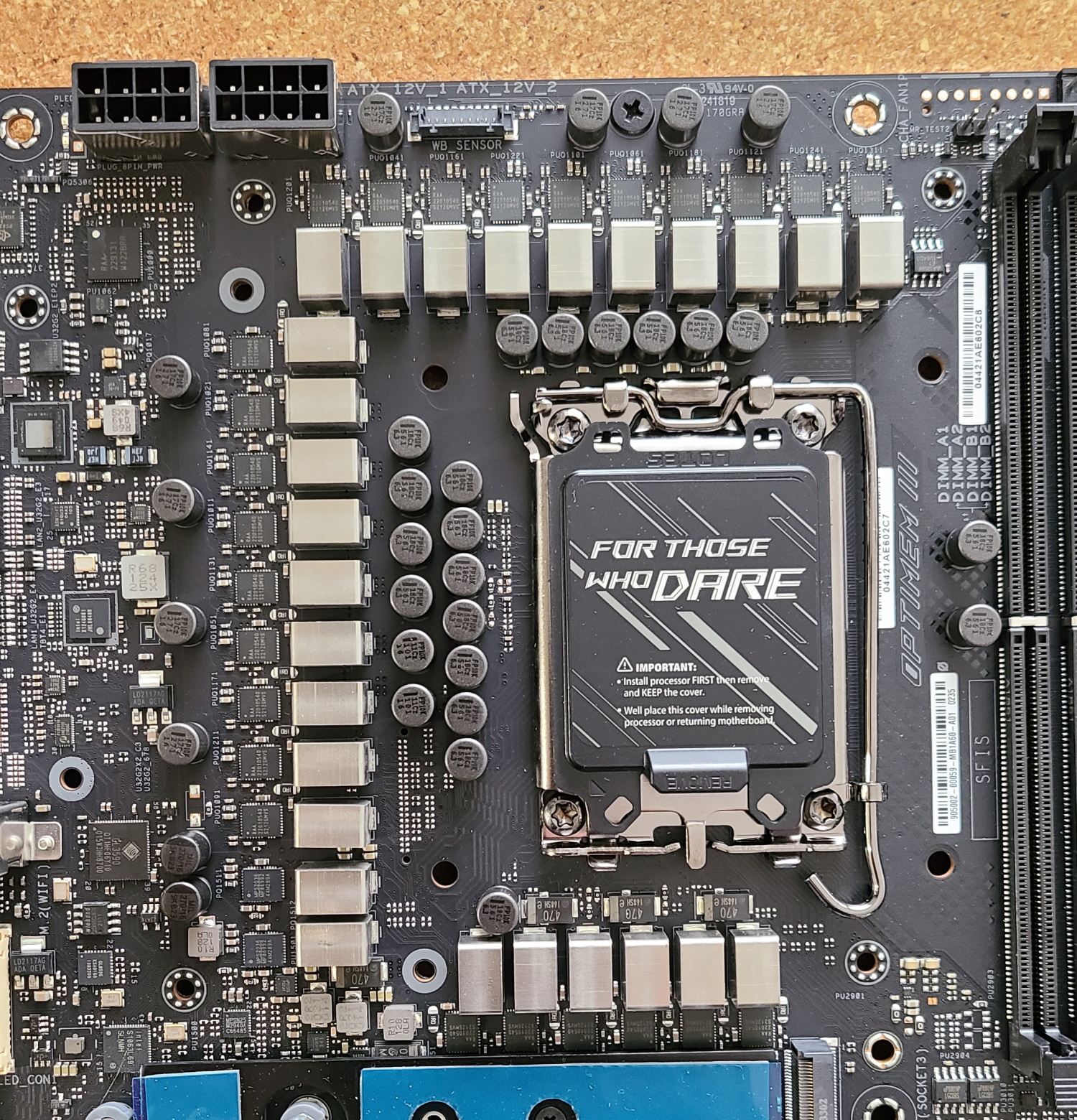Tom's Hardware Verdict
At $1,099.99 and $1,999.99, the ROG Z690 Extreme/Glacial are the best Asus has to offer on Intel’s 12th Gen platform. Jammed full of features, they don’t lack for anything, except pricing anywhere near what most people would call affordable.
Pros
- +
+ PCIe 5.0 x4 M.2 socket
- +
+ Premium audio ecosystem
- +
+ Robust 24-phase 105A VRMs
- +
+ Fast USB, including Thunderbolt 4
Cons
- -
Next-level flagship pricing
- -
Dot Matrix LED accents are polarizing
Why you can trust Tom's Hardware
Through every generation of motherboards (and graphics cards), every board partner does their best to offer a complete lineup. From budget to flagship-class hardware, there’s something for everyone. Today we’re covering Asus’ flagships in the ROG Z690 Maximus Extreme ($1,099.99) and the water-cooled Extreme Glacial ($1,999.99). Both boards present users with the best hardware available for the platform, while the Glacial raises the bar adding a custom EKWB full cover block to cool the CPU, VRMs, chipset, and more. But are they worth the high price of admission?
Hardware-wise, both the Extreme and Extreme Glacial are the same. Both have the overbuilt 25-phase VRM, a PCIe 5.0 M.2 socket (plus four others), Wi-Fi 6E and 10 GbE connectivity, flagship-class audio, AniMe Matrix and LiveDash displays, and too many other features to list here. Although the E-ATX-size boards look different due to the water block, they both exude a premium appearance and style that works with most builds. If you’re into RGB LED lighting, both boards have you covered, with the Glacial using a lot more.
In our testing, both boards performed basically identically. When we bring other Z690 boards into the mix, we found them average overall, with no surprises in most tests. Our gaming results were a couple of frames per second (fps) slower than other boards, but nothing you’d notice. None of the results were the fastest or slowest but settled in nicely along the mean. Power use was slightly higher than average for both versions of the Extreme, but not out of line. In short, the two Extreme boards perform well out of the box.
Below, we’ll take a closer look at the features of the boards, including the overclocking bits, water cooling block, and any other item that makes the Extreme, well, extreme. Does it have what it takes to make our best motherboards list? We’ll answer that question and share our thoughts on if it’s worth paying such a premium for a motherboard. But first, here’s a detailed list of the Z690 Extreme and Extreme Glacial’s specifications, direct from Asus.
Specifications: Asus ROG Maximus Z690 Extreme / Extreme Glacial
| Socket | LGA1700 |
| Chipset | Z690 |
| Form Factor | E-ATX |
| Voltage Regulator | 25 Phase (24 105A SPS MOSFETs for Vcore) |
| Video Ports | (1) HDMI (v2.1) |
| Row 5 - Cell 0 | (2) Thunderbolt 4 (Type-C) |
| USB Ports | (1) Thunderbolt 4 Type-C (40 Gbps) |
| Row 7 - Cell 0 | (1) USB 3.2 Gen 2x2 Type-C (20 Gbps) |
| Row 8 - Cell 0 | (1) USB 3.2 Gen 2 Type-C (10 Gbps) |
| Row 9 - Cell 0 | (7) USB 3.2 Gen 2 Type-A (10 Gbps) |
| Network Jacks | (1) 2.5 GbE |
| Row 11 - Cell 0 | (1) 10 GbE |
| Audio Jacks | (5) Analog + SPDIF |
| Legacy Ports/Jacks | ✗ |
| Other Ports/Jack | ✗ |
| PCIe x16 | (2) v5.0 (x16, x8/x8) |
| PCIe x8 | ✗ |
| PCIe x4 | (1) v3.0 (x4) |
| PCIe x1 | ✗ |
| CrossFire/SLI | Supports Nvidia 2-Way SLI |
| DIMM slots | (4) DDR5 6400+(OC), 128GB Capacity |
| M.2 slots | (1) PCIe 5.0 x4 (128 Gbps), PCIe up to 110mm) |
| Row 22 - Cell 0 | (1) PCIe 4.0 x4 (64 Gbps), PCIe (up to 110mm) |
| Row 23 - Cell 0 | (1) PCIe 4.0 x4 (64 Gbps), PCIe/SATA (up to 80mm) |
| Row 24 - Cell 0 | (2) DIMM.2 AIC - PCIe 4.0 x4 (64 Gbps) |
| U.2 Ports | ✗ |
| SATA Ports | (6) SATA3 6 Gbps (Supports RAID 0/1/5/10) |
| USB Headers | (1) Thunderbolt 4 (40 Gbps) |
| Row 28 - Cell 0 | (1) USB v3.2 Gen 2x2, Type-C (20 Gbps) |
| Row 29 - Cell 0 | (2) USB v3.2 Gen 2 (10 Gbps) |
| Row 30 - Cell 0 | (2) USB v2.0 (480 Mbps) |
| Fan/Pump Headers | (8) 4-Pin (CPU, Chassis, Radiator, W Pump) |
| RGB Headers | (1) aRGB (3-pin) |
| Row 33 - Cell 0 | (1) RGB (4-pin) |
| Row 34 - Cell 0 | (1) 6-pin ARGB Gen2 header (2x ARGB headers) |
| Diagnostics Panel | 2-character debug LED |
| Internal Button/Switch | Power/Flex/BCLK + and -/slow mode/vlatch/retry/bios/safe boot |
| SATA Controllers | ASMedia ASM1061 |
| Ethernet Controller(s) | Intel I225-V (2.5 Gbps) |
| Row 39 - Cell 0 | Marvell AQtion 10 GbE |
| Wi-Fi / Bluetooth | Intel AX210 Wi-Fi 6E (2x2 ax, MU-MIMO, 2.4/5/6 GHz, 160 MHz, BT 5.2) |
| USB Controllers | ASMedia ASM1074 |
| HD Audio Codec | Realtek ALC4082 |
| DDL/DTS | ✗ / DTS: Sound Unboaund |
| Warranty | 3 Years |
Inside the Boxes of the Z690 Extreme and Extreme Glacial
Inside the boxes, along with the motherboards, Asus includes a slew of accessories (one of the most comprehensive we’ve seen) designed to complement board functionality as well as get your system up and running without a trip to the store. Between the two boards, the accessory stack is the same, outside of the water cooling parts that come with the Extreme Glacial. Below is a complete list of the included extras from both boards.
Asus includes your standard accessories, including SATA cables, Wi-Fi antenna, etc. Below is a complete list of the included extras.
- 1-to-3 ARGB splitter cable
- 1-to-2 ARGB splitter cable
- (2) 1-to-4 fan splitter cables
- RGB extension cable
- (3) ROG weave SATA 6G cables
- (4) SATA 6Gb/s cables
- 3-in-1 Thermistor cables pack
- ROG Fan Controller
- Fan EXT PWR cable
- ARGB input cable
- USB input cable
- ROG Fan Controller 3M Mounting tape
- Fan Controller manual
- ROG DIMM.2 with heatsink
- M.2 pad for ROG DIMM.2
- (2) M.2 screw package for ROG DIMM.2
- ROG True Voltician
- (4) Cables for ROG True Voltician
- ASUS Wi-Fi moving antennas
- M.2 SSD screw package
- Q-connector
- ROG CLAVIS DAC
- ROG graphics card holder
- ROG key chain
- ROG logo plate stickers
- ROG screwdriver
- ROG stickers
- ROG thank you card
- Thermal pad package for M.2 heatsink
- USB drive with utilities and drivers
- User guide
The Extreme Adds
Get Tom's Hardware's best news and in-depth reviews, straight to your inbox.
- Monoblock
- (3) Screw package for monoblock
- Thermal pad for monoblock
- Fittings for monoblock (hard tube)
- M.2 heatsink
Design of the ROG Maximus Extreme/Extreme Glacial

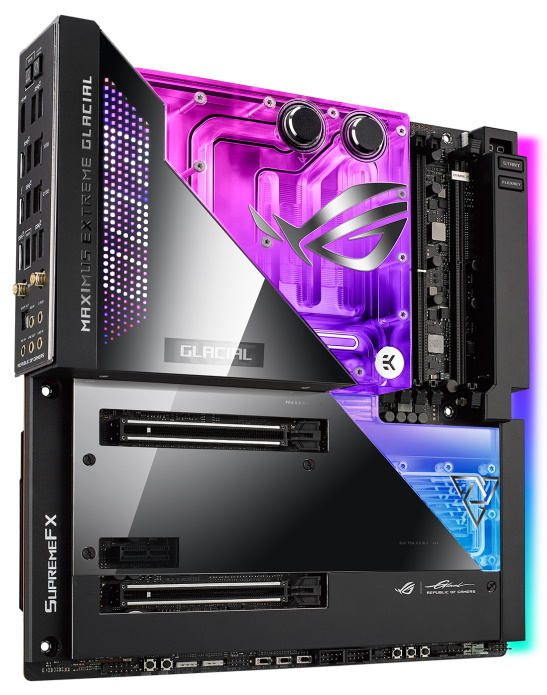
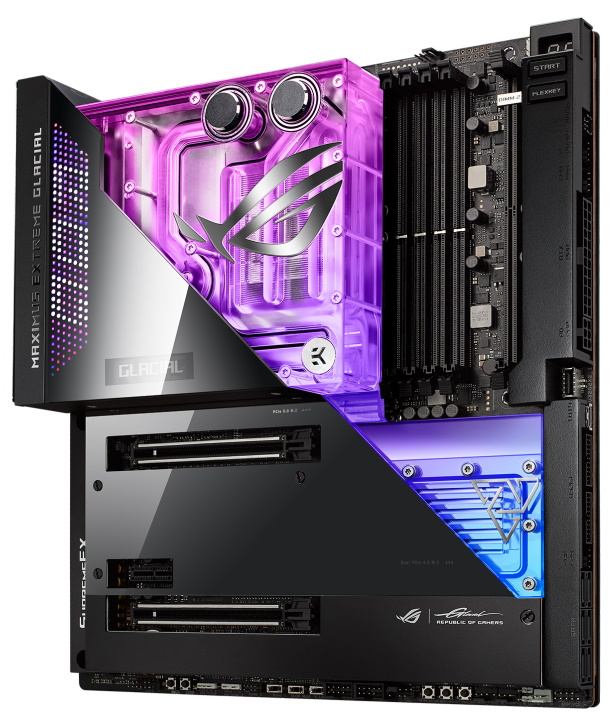


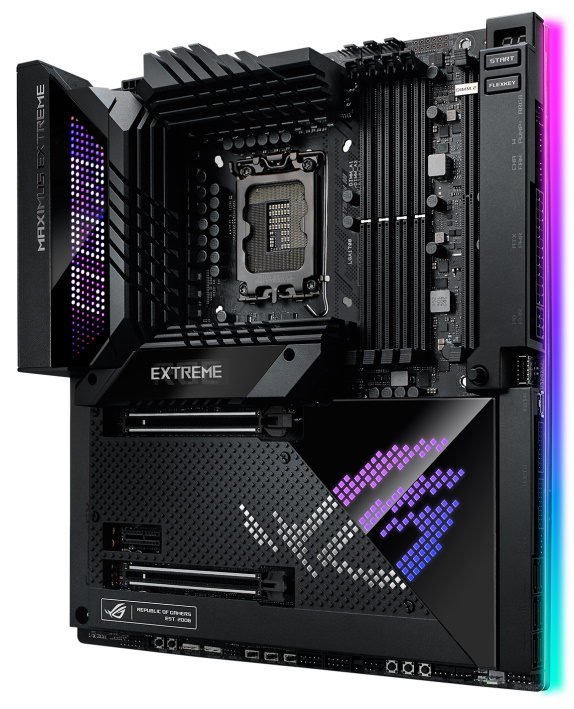
Starting with the Extreme, Asus uses a jet black PCB and heavy metal heat sinks and shrouds that cover an overwhelming majority of the board. The oversized and heat pipe-connected VRM heatsinks surround the socket and reach over the IO area. On top of the VRM heatsink is the customizable Asus AniMe Matrix LED display (a carryover from the company’s ROG Zephyrus G14 laptop), while just below that is the LiveDashOLED to display system information (among other things). The heatsinks around the M.2 sport small bumps to give the board a unique look and increase the surface area to dissipate the heat from the SSDs below.
The right edge is covered by a shroud hiding the horizontal connections for fans and power. The chipset heatsink sports an RGB LED-lit ROG symbol, while under the right edge is an RGB strip that runs the full length of the board. A backplate protects the rear of the board and offers some passive cooling on the VRMs. Overall, the Maximus Extreme is a good-looking board that gives off a premium vibe, but the dot matrix feature is a love-it-or-hate-it feature for sure.
The Glacial takes the premium vibe the ‘base’ Extreme has and takes it to a whole different level. The included monoblock replaces the heatsinks on the board cooling the CPU, VRMs, M.2 socket(s), and the chipset. Around the socket area, the clear plexi gives way to several integrated ARGB LEDs in the block that shine past the prominent silver Asus ROG branding. You still get the benefits of the Matrix LED and LiveDash OLED in the Glacial, and it blends in a lot better here than on the regular Extreme. Between the EK block, horizontal connectivity and shrouds, you can barely see the PCB except where you need to (where there are headers for fan, RGB, etc. The Extreme Glacial is one of the most high-end-looking motherboards available. Both boards beg to be the centerpiece of your PC.

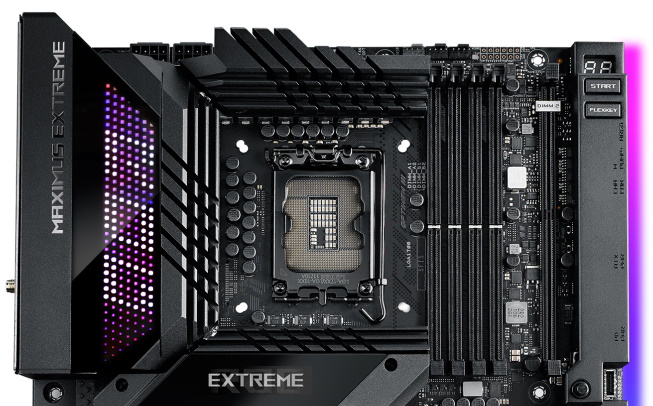
On the ‘base’ Extreme, the VRM heatsinks rise around the socket area like seats in a sports stadium. The large heatsinks offer a lot of surface area and connect via a heat pipe to share the VRM and M.2 socket heat load. On top of the left VRM bank sits the AniMe Matrix LED, while just below that is the 2-inch LiveDash OLED screen. Both can be personalized, with the LiveDash sharing system information (think voltage and speeds) and images, while the AniMe Matrix LED is more for aesthetics and personalization. You can control what these display through the Asus Armoury software. Just above the heatsink are two 8-pin EPS connectors (one required) to power the CPU.
The Glacial replaces the stadium seating-like VRM heatsinks with a nickel-plated EK block that covers and cools the VRMs, CPU, and the top M.2 socket. The gloss finish reaches out over the IO panel and down to the top VRM socket which yields an even more premium look. The AniME Matrix and LiveDash OLED have a much cleaner implementation on the Glacial since it’s integrated into the block. RGB LEDs shine brightly through the thick acrylic block, backlighting the ROG symbol branding.
To the right of the socket, both motherboards look the same and have the same features. There are four unreinforced, single-side locking DRAM slots supporting up to 128GB of DDR5 with speeds listed to DDR4 6400+. Of course, your mileage will vary as reaching these speeds depends on the memory kit used and having a CPU with an integrated memory controller capable of doing so. We had no issues with our ADATA DDR5 6000 kit using XMP.
Above the DRAM slots are three (of eight) 4-pin fan/pump headers. In this case, we have the CPU_FAN, CPU_OPT, and CHA_FAN1P headers which are Q-Fan controlled by default. These headers (and the rest of the chassis fans and rad fans) support up to 1A/12W. The two pump headers (W_PUMP+1/2) output up to 3A/36W, supporting nearly all pumps designed for PC watercooling.
All of the holes on the board to the right are for the Asus ProbeIt functionality. With these, you can use a multi-meter to check voltages more accurately compared to software. ProbeIt covers all major voltages, including VCore, VIn, VDD, SA and several others. While most users don’t need this level of granularity and accuracy, I want to see everything Asus has to offer on the flagship and am happy to see it here. For those who truly push the limits of their processor, this is a useful tool to have.
Sitting between the right edge of the board and DRAM slots is the DIMM.2 socket. This slot houses the included DIMM.2 module which adds two additional M.2 sockets to the board. The add-in-card–which looks like RAM–runs at PCIe 4.0 x4 speeds for each module and supports up to two 110mm PCIe storage devices.
Along the right edge, the Extreme(s) sport a plastic shroud that covers the unsightly connectors and simple buttons. A 2-character debug LED is visible from the top, along with rectangle-shaped Start (power) and reset buttons. Sitting horizontally under the shroud are two 4-pin fan headers, the 24-pin ATX connector to power the board, and a supplemental 6-pin PCIe connector for additional board power for multi-GPU configurations. Also located here is the new 6-pin Gen2 addressable RGB connector that fits RGB WS2812B or WS2812B-based LED strips at up to 3A(5V). Sticking up around the shroud is a front panel USB 3.2 Gen 2x2 (20 Gbps) Type-C header.
The air-cooled Extreme also has the PCIe slot Q-Release button that unlocks the primary GPU socket. Even though most users don’t change their graphics card often, that button is high on my list for quality of life changes, as pressing the latch on the back of the PCIe slots can prove difficult, especially on high-end boards with a lot of heatsinks/shrouds and little room to get an adult finger there to press it. I don’t know about you, but I get nervous when I have to stick a screwdriver between the back of the graphics card and some of these heatsinks.
The Asus ROG Z690 Extreme and Extreme Glacial has one of the most impressive power delivery sections in an enthusiast-class motherboard. The 25-phase configuration has 24 phases dedicated to Vcore running in a teamed configuration. Essentially, the 20-channel Renesas RAA229131 controller feeds a pair of 105A Renesas RAA22010540 SPS MOSFETs. The 2,520A available is the highest I’ve come across. You’ll have no issues powering the flagship Alder Lake-based processor in this board, even when using sub-ambient cooling to push the limits.
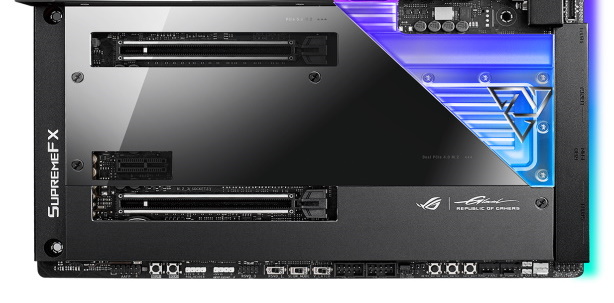
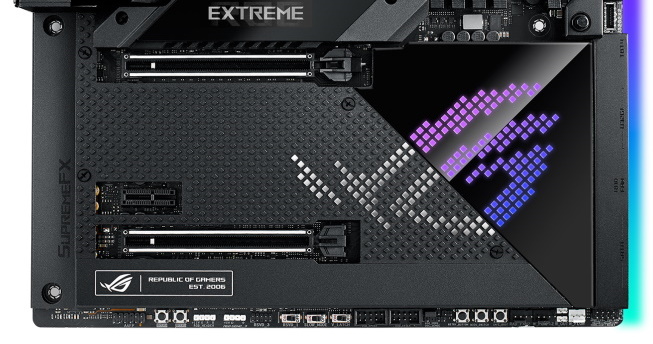
Although appearance of the bottom half of the boards is different, the hardware configuration is again the same. Under the left side, metal shrouds cover one of the better audio implementations on the Z690 platform. The Supreme FX (Realtek) ALC4082 codec is hidden below, which has higher SNR stereo playback output and recording input values than the ALC4080 we’re used to. Instead of the conventional HDA interface for audio, it uses USB to improve playback resolution from 192 to 384 kHz. Additionally, the ESS Sabre 9018Q2C integrated DAC amplifier provides low harmonic distortion and, according to Asus, “conveys all the subtlety and nuances of the audio track.” Regardless of whether you can hear the difference, on paper, it’s an improvement over the already capable ALC4080 codec many Z690 boards work with. It doesn’t get better than this out of the box–or at least out of the motherboard box.
In the middle of the board are three PCIe slots. The two full-length reinforced slots connect through the CPU and offer sixteen PCIe 5.0 lanes. The top, primary graphics slot runs up to PCIe 5.0 x16 if the second slot isn’t populated and you’re not using the PCIe 5.0 M.2 socket. The second slot runs up to PCI 5.0 x8 speeds. Asus lists 2-Way SLI support but doesn't mention AMD Crossfire.
Next, hidden under the shroud/full coverage water block (depending on the board), are the three M.2 sockets. The top socket hides under the LiveDash OLED and heatsink/block. The slot connects through the CPU and runs PCIe 5.0 x4 (128 Gbps) speeds supporting PCIe devices only. When this socket is in use, the secondary graphics slot is disabled and the primary slot drops to PCI 5.0 x8. Those wondering about video card performance need not worry the difference with current-gen cards is negligible.
M.2_2 and M.2_3 SSD sockets connect through the chipset with a maximum throughput of PCIe 4.0 x4 (64 Gbps) and fit up to 110mm devices. The M.2_3 socket supports SATA-based modules as well as PCIe. You’ll find the other two M.2 sockets (for a total of five) on the DIMM.2 module.
As we shift focus to the right, over the chipset area to the edge of the board, we run into another plastic shroud covering more horizontal connections. From the top, there’s a Thunderbolt 4 Type-C port, two USB 3.2 Gen 1 (5 Gbps) ports, a 4-pin ‘RAD’ fan header, and six SATA ports. The SATA ports support RAID modes 0/1/5/10 on the integrated (top four) ports. The SATA “E” ports use an external controller and do not work in RAID.
Across the bottom of the boards are a slew of headers, buttons and switches designed for overclocking, switching BIOSes, additional USB ports, RGB, and even some water flow headers. Below is a complete list of all the headers across the bottom of the boards.
- Front panel audio
- BCLK +/- buttons
- 4-pin RGB header
- 3-pin ARGB header
- RSRVD
- Slow Mode switch
- VLatch switch
- (2) USB 2.0 headers
- LN2 Mode jumper
- Temperature sensor jumper
- Retry/BIOS/Safe Boot buttons
- (2) 4-pin fan headers
- Waterflow in/out/flow sensors
- Front panel header
Swinging around to the rear IO area, we run into the preinstalled IO plate that blends in nicely with both board’s aesthetics. The black background with white writing makes the ports easily identifiable.
From left to right, we run into BIOS flashback and CMOS reset buttons and then to the first two (of seven total) USB 3.2 Gen 2 (10 Gbps) ports. Below is the HDMI 2.1 port for use with integrated graphics. Continuing right, we run into the ethernet ports. The first is a Marvell AQtion 10 GbE port, and next to it is the 2.5 GbE Intel port. On the bottom of these stacks are three Type-C ports. From left to right is a USB 3.2 Gen 2 (5 Gbps) port, Thunderbolt 4 (40 Gbps) port, and a 3.2 Gen2x2 (20 Gbps) port. In all, the seven Type-A ports should be enough, and there’s a Type-C on top of that. While this isn’t the most USB ports we’ve seen, the USB layout is some of the fastest available, with nothing slower than 10 Gbps ports here. Next up are the Wi-Fi 6E antenna connections and the 5-plug plus SPDIF audio inputs, backlit by colored LEDs that match the port.
MORE: Best Motherboards
MORE: How To Choose A Motherboard
MORE: All Motherboard Content

Joe Shields is a staff writer at Tom’s Hardware. He reviews motherboards and PC components.
-
wifiburger "Designed to show off the best Asus has to offer" yeah... of course with that crazy price tag on it !Reply
and at the same time, the entry level z690 are complete joke, audio chipset from 10years ago, no usb-c front panel, no wifi, very little fan headers, anemic rear io panel :ROFLMAO: -
WilliamRJK Crossfire does not need to be mentioned as it works on anything with at least 4 PCIe lanes per slot. A tech writer should know that.Reply -
ocer9999 Still preefer the Asrock Z690 Aqua series, if you are on watercooling you most likely be going to overclock and there's no better motherboard than that atm for this intel generation.Reply
